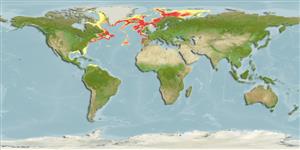Common names from other countries
Environment: milieu / climate zone / depth range / distribution range
Ecología
; rango de profundidad 150 - 1618 m (Ref. 1797). Temperate
Distribución
Países | Áreas FAO | Ecosistemas | Ocurrencias, apariciones | Introducciones
Arctic and Atlantic Ocean.
Length at first maturity / Tamaño / Peso / Age
Maturity: Lm ? range ? - ? cm
Maximum depth from Ref. 116112. Slope (Ref. 19). Epibiotic (Ref. 116112).
Life cycle and mating behavior
Madurez | Reproducción | Puesta | Huevos | Fecundidad | Larva
Members of the class Pycnogonida are gonochoric and sexually dimorphic. During copulation, male usually suspends itself beneath the female. Fertilization occurs as the eggs leave the female's ovigers. Males brood the egg masses until they hatch. Life cycle: Eggs hatch into protonymphon larva then to adults.
Bamber, R.N. and M.H. Thurston. 1995. (Ref. 1797)
IUCN Red List Status (Ref. 130435)
CITES status (Ref. 108899)
Not Evaluated
Not Evaluated
Human uses
| FishSource |
Herramientas
Más información
Age/Size
Crecimiento
Length-weight
Length-length
Morfología
Larva
Abundancia
Fuentes de Internet
Estimates based on models
Preferred temperature
(Ref.
115969): 1 - 10.4, mean 4 (based on 445 cells).
Price category
Unknown.
